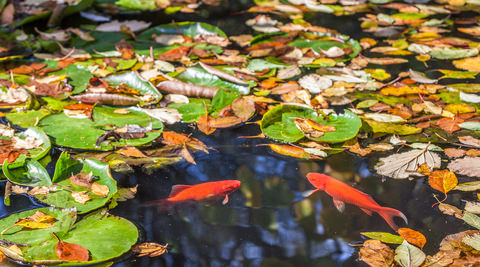| Back to Back Issues Page |
 |
|
The Goldfish Gazette, Issue #140 Changing seasons September 01, 2025 |
Goldfish Care TipsA Free Monthly Resource For Goldfish Enthusiasts In This Issue The Northern hemisphere is moving into autumn, and the Southern is preparing for the busy spring period. Changing Seasons
Northern HemisphereMoving into autumn means your Goldfish are preparing for winter, and want to put on as much body fat as possible. The more fat they have, the better their condition will be coming into spring, which means their immune systems will be strong and spawning will be possible, as egg production requires fat.Feeding should be increased in early autumn and gradually decreased as winter approaches. Mid to late autumn is an ideal time to clean out ponds and filters, especially if perennial aquatic plants such as water hyacinth or lilies are present, as they create a large amount of litter that will decay at the bottom of the pond, creating ammonia pockets. Pond filters that will be turned off over winter to avoid stressing your fish with unnecessary exertion while they are semi-dormant need to have all water removed to prevent freezing damage. If you have been raising juveniles from your spring spawnings, now is the time to start selecting the ones you want to keep and selling off the rest. Any juveniles under about 50mm (2 inches) may need to be housed indoors if you have severe winter temperatures (pond frozen over for a month or two). Likewise, if you have unplanned spawnings, you need to remove unwanted fish to reduce the bio-load in the pond. My fish always seem to sneak in a spawning or two, and if aquatic plants have provided the slightest cover, I end up with 10-20 juveniles I don’t want by the end of summer. Southern HemisphereChecking the health of pond fish is important at the start of spring.Protozoan parasites and other pathogens are multiplying rapidly while fish are still not fully active, so their immune systems are at their weakest, especially fish that didn’t gain enough fat during autumn. Any fish that appear underweight should be removed from the pond, put into a mild salt bath, the temperature slowly raised to around 18-20oC (64-68oF), and fed small amounts frequently. If any fish doesn’t have a healthy appetite, increase the salt to a 0.3% solution, as a protozoan parasite such as Costia may have attacked it. Check the adults you are planning to spawn that they are healthy, and prepare to start feeding heavily once water temperatures rise above 12oC (54oF). Any fish that aren’t in good condition will struggle to have a successful spawning if they are underweight in early spring. Keep a close eye on temperatures as Goldfish will spawn at 17-18oC (63-64oF). Filters can be recommissioned after checking for seized components, but remember, it will take at least a month before they are cycled. Comments? Ideas? Feedback? I'd love to hear from you. Just reply to this e-zine and tell me what you think, or what topics you want to be covered. www.facebook.com/aboutgoldfish |
| Back to Back Issues Page |
